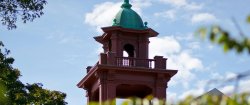Seeing Campus Differently
With classes set to begin, masks and safety precautions are integral to the University’s restart
Posted in: Homepage News, University

You can see it in their eyes, above their masks, a window to a mix of emotions at the start of a fall semester like no other.
Mostly excited, but not sure what to expect, students are calling this the “COVID semester,” with face coverings and social distancing obligatory, and online self-screenings required by all students, employees and visitors whenever they come to campus.
“We’re embracing this idea that we’re doing what we need now for everyone to be safe,” says junior Robert Onoz, a Physics major with a concentration in Physical Science Education from Ridgefield, New Jersey. “It’s less scary that way too, to reassure us that this isn’t the ‘new normal.’ This is something we’re going to go through now, but it will change.”
Classes begin August 25 with instruction delivered in a format called HAWKFlex: face-to-face, hybrid (on campus and online) and fully online. Students who require, or desire, to live in the residence halls have been moving in in staggered shifts over the past few weeks.
Dining halls are preparing pre-ordered food and “grab and go” take-out, creating outdoor dining spaces and opening indoor dining with reduced capacity, social distancing and other safety rules in place. Sprague Library is open with added curbside services. Everywhere are signs and other visual safety reminders, among the extensive procedures in place for virtually every aspect of life at the University.
“These are unprecedented times,” observes Rebecca Monsanto, a sophomore studying Molecular Biology from Elizabeth, New Jersey.
Monsanto’s face, even under a mask, may seem familiar. She is among the students featured in Red Hawk Restart communications to demonstrate how Montclair State has prepared for a safe return under New Jersey’s plan for higher education.
The students who appear on the University’s website and a welcoming video, say they were happy to be back on campus. “Taking a break from March to August and coming back, I was like, ‘Oh, wow,’” Onoz says. “Montclair State is beautiful.”
“You can see that our eyes are lit up,” adds Paulette Gando-Duenas, a junior History major from Lodi, New Jersey. “You can see that we are smiling.”

Not everyone will be back on campus in the fall – as some have chosen a fully online schedule and about 60 percent of classes are online. Dana Fields, a junior Television and Digital Media major from North Brunswick Township, has decided to live at home and finish general education requirements with the online course option.
“It’s hard,” she says. “I want to see my friends, and I miss my freedom.” But she also worries about what she sees on social media, young people at parties and on the beach, not always social distancing or wearing masks. “I’m not saying that people intentionally want to put people in danger. I don’t think that’s the case. I just think that they miss their freedom.”
Fields participated in the video because of the safety protocols on campus, but has turned down social invitations because her mother and brother are vulnerable to the virus and Fields says she doesn’t want to get them sick. “Creating content is my safe haven right now.” Among her social media projects is a film about her brother Kendall, who has autism, and how the pandemic has disrupted his schooling and routines.
The health and economic impacts of the coronavirus have been felt by many in the Montclair State community. Monsanto, who lost her job during the pandemic, decided to live in the residence halls, where she is better able to focus on her studies. As a Molecular Biology major, she will have labs on campus. “I expect to have to comply with and implement the social distancing rules in order to ensure my safety as well as my peers’,” she says.
Gando, a commuter active in student life, says she’s looking forward to catching the eye of some of the University’s 3,100 new students to encourage them to participate in campus events and meetings that will be allowed to be held both remotely and in person, as long as they are consistent with the safety guidelines.
“Being able to work in the SGA office, I’ve seen how the administration is on top of things and how they want the students to be heard,” she says.

There’s a lot of uncertainty,” Onoz adds, “and unfortunately, a lot of fear. People are scared because they don’t know what the fall is going to be like.”
That’s part of the reason Onoz participated in the restart video. “It’s nice to know that students watching the video can see the kid in the grey shirt talking to people. He’s wearing a mask but he seems to be having a great time. It provides a bit of hope.”
Onoz is a future teacher, recently admitted into the Department of Teaching and Learning’s 5-year BS/MAT Dual Certification Program. He’ll be working as a supplemental instructor for freshman physics, and has been training on best practices for online learning.
“This semester, especially, there’s going to be a lot of integration of technology, a lot of innovative ways to present material with new tools and different types of media,” he says.
“I wouldn’t want this to last forever. I love in-person classes and I believe there are nuances to students being in a classroom and being able to talk to each other that you can’t replace. But our professors are fresh out of training. As an alternative, to keep people safe, I think this fall will be alright.”
Story by Staff Writer Marilyn Joyce Lehren
